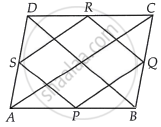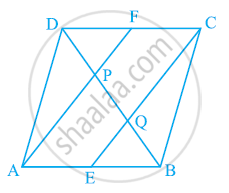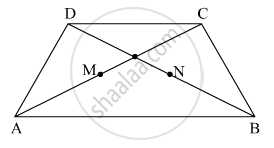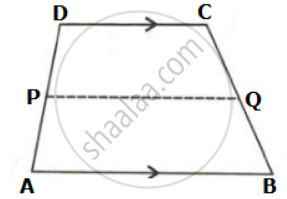Advertisements
Advertisements
Question
P, Q, R and S are respectively the mid-points of the sides AB, BC, CD and DA of a quadrilateral ABCD in which AC = BD. Prove that PQRS is a rhombus.
Solution
Given: In a quadrilateral ABCD, P, Q, R and S are the mid-points of sides AB, BC, CD and DA, respectively.
Also, AC = BD
To prove: PQRS is a rhombus.

Proof: In ΔADC, S and R are the mid-points of AD and DC respectively.
Then, by mid-point theorem.
SR || AC and SR = `1/2` AC ...(i)
In ΔABC, P and Q are the mid-points of AB and BC respectively.
Then, by mid-point theorem.
PQ || AC and PQ = `1/2` AC ...(ii)
From equations (i) and (ii),
SR = PQ = `1/2` AC ...(iii)
Similarly, in ΔBCD,
RQ || BD and RQ = `1/2` BD ...(iv)
And in ΔBAD,
SP || BD and SP = `1/2` BD ...(v)
From equations (iv) and (v),
SP = RQ = `1/2` BD = `1/2` AC [Given, AC = BD] ...(vi)
From equations (iii) and (vi),
SR = PQ = SP = RQ
It shows that all sides of a quadrilateral PQRS are equal.
Hence, PQRS is a rhombus.
APPEARS IN
RELATED QUESTIONS
In a parallelogram ABCD, E and F are the mid-points of sides AB and CD respectively (see the given figure). Show that the line segments AF and EC trisect the diagonal BD.

ABC is a triangle right angled at C. A line through the mid-point M of hypotenuse AB and parallel to BC intersects AC at D. Show that
- D is the mid-point of AC
- MD ⊥ AC
- CM = MA = `1/2AB`
ABCD is a rhombus, EABF is a straight line such that EA = AB = BF. Prove that ED and FC when produced meet at right angles
In the adjacent figure, `square`ABCD is a trapezium AB || DC. Points M and N are midpoints of diagonal AC and DB respectively then prove that MN || AB.

In triangle ABC, the medians BP and CQ are produced up to points M and N respectively such that BP = PM and CQ = QN. Prove that:
- M, A, and N are collinear.
- A is the mid-point of MN.
In ΔABC, AB = 12 cm and AC = 9 cm. If M is the mid-point of AB and a straight line through M parallel to AC cuts BC in N, what is the length of MN?
In ΔABC, BE and CF are medians. P is a point on BE produced such that BE = EP and Q is a point on CF produced such that CF = FQ. Prove that: A is the mid-point of PQ.
In parallelogram ABCD, P is the mid-point of DC. Q is a point on AC such that CQ = `(1)/(4)"AC"`. PQ produced meets BC at R. Prove that
(i) R is the mid-point of BC, and
(ii) PR = `(1)/(2)"DB"`.
In the given figure, ABCD is a trapezium. P and Q are the midpoints of non-parallel side AD and BC respectively. Find: PQ, if AB = 12 cm and DC = 10 cm.
D and E are the mid-points of the sides AB and AC of ∆ABC and O is any point on side BC. O is joined to A. If P and Q are the mid-points of OB and OC respectively, then DEQP is ______.
